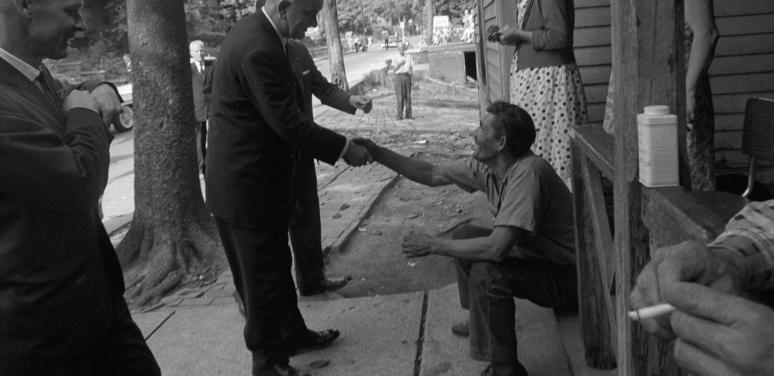History of the War on Poverty

As you may know, Kansas Legal Services is part of the national legal aid movement that was born in the War on Poverty in the early 1960s. KLS grew out of the movement that believed everyone deserved equal access to justice, without regard to their ability to pay for services.
The National Legal Aid and Defender Association (NLADA) has a film about the history of civil legal aid in the United States on their website.
Strands of Justice is a documentary film that explores the history of civil legal aid in the United States, rooting today's advocates in the significance of this work since its inception.
Click Here to Access the Full Film
The Sargent Shriver Peace Institute website also contains the history of legal aid and of other programs that were born during the War on Poverty and because of the War on Poverty.
The Poverty Law Center's Video about the War on Poverty.
Below is a brief history of the War on Poverty.
The War on Poverty represents one of the most substantial government-led strategies to address poverty in the United States.
As its leader, Sargent Shriver was tasked with creating policy and programs that would not just alleviate poverty, but provide a pathway towards eliminating it permanently.
On February 1, 1964 - barely two months after the assassination of President Kennedy, and the morning after returning from a grueling, three-week trip to Asia as Director of the Peace Corps -- Sargent Shriver received a phone call at home from President Lyndon Johnson.
The President informed him that, at a press conference that afternoon, he would be announcing Shriver's appointment as the Director of the War on Poverty; you can hear their conversation here.
Shriver was concerned - he’d had no time to prepare and no plan in place. Furthermore, the Peace Corps had enjoyed early success but was in many ways still a nascent program - what would happen if it’s director suddenly left?
Johnson was adamant. "You've got the responsibility, you've got the authority, you've got the power, you've got the money. Now, you may not have the glands."
Sargent Shriver famously replied: "I've got plenty of glands."
Ultimately, Sargent Shriver’s sense of duty and recognition of a call to service guided him forward. He would remain the director of The Peace Corps and lead The War on Poverty, becoming its conceiver, administrator, and architect.
In Shriver's words,
"The simplest description of the War on Poverty is that it is a means of making life available for any and all pursuers. It does not try to make men good - because that is moralizing. It does not try to give men what they want - because that is catering. It does not try to give men false hopes - because that is deception. Instead, the War on Poverty tries only to create the conditions by which the good life can be lived - and that is humanism."
Shriver began with research. He summoned anyone who knew anything about poverty - activists, scholars, priests, nuns, reporters - and started with a simple question, “If you were in my position, what would you do?”
Then, he went looking for what author Michael Harrington called, “The Other America” - the invisible poor.
As Shriver uncovered the systemic roots of poverty - towns in Appalachia that did not have access to running water, black Americans in the South who were segregated and oppressed by Jim Crow laws, housing ghettos in the North - the necessity of The War on Poverty began to come into sharp focus. As Shriver felt frequently in his life, he was being called to serve.
In 16 weeks, Shriver had a plan. The War on Poverty would be a multi-faceted initiative designed to transform the economic and social roots of the conflict over civil rights in America.
The heart of its programming would be Community Action.
“‘Community Action’ as its name implies, is local action.” Shriver explained. “We depend completely on local communities to come to Washington with their own programs of combating poverty in the ways that they see fit to do it in their own home town.”
The center of Community Action was the idea that community self-empowerment would lead to self-reliance.
In solving the problem of poverty, Sargent Shriver wanted “maximum feasible participation” by the people most affected by poverty issues.
Winning over the votes needed to pass the legislation was difficult. Many members of Congress were skeptical of “democratic socialist” ideals and still heavily influenced by racial paradigms of the time.
Shriver fought tirelessly, visiting each individual member of congress to rally them behind the goals of The War on Poverty - it was not just some lofty ideal but a practical and necessary venture to give equal access and opportunity to millions of Americans.
On August 8th, 1964, the bill passed with a larger margin than expected - 226-184.
On August 20th, 1964, President Johnson signed the Economic Opportunity Act and the War on Poverty was officially launched.
Soon after, Shriver was sworn in as the Director of The Office of Economic Opportunity.
In its pursuit of eliminating poverty by empowering poor communities through community action and encouraging a national dedication to service, the OEO created the following programs, all of which still exist today:
Head Start
The Bureau of the Budget had produced data at Shriver’s request on how the demographics of poverty broke down across the United States.
Shriver was struck by numbers that showed that:
- 50% of the nation’s poor were children.
- 6 million of them were under the age of 6.
Although Head Start had not initially been a part of the OEO’s legislation, Shriver was adamant that the war could not be won without taking action to address child poverty.
Research at the time showed that the cycle of poverty started early. Children without equal access to food, books, school supplies, and adult guidance faced significantly more obstacles in school, which in turn could affect the course of the rest of their lives.
In order to break the cycle of poverty, setting children up for success in school - and doing it early - was key.
With the leadership of several child psychologists and physicians, Shriver and the OEO created Head Start, a community-responsive program geared towards pre-school children, giving them the tools they needed, from meals to mentorship, to prepare for entering elementary school.
While some child development experts thought the program should begin with a small experiment - 2,500 children or so - Shriver knew that to make an impact the program had to reach as many children as possible with its launch. “We’re going to write Head Start across the face of this nation so that no Congress and no president can ever destroy it,” he said.
During the program’s first summer, 580,000 children had spent time in a Head Start center, receiving pre-schooling, meals, medical check-ups, and eye exams.
Since 1965, Head Start has served over 36 million children.
Legal Services
In 1964, Jean and Edgar Cahn wrote “The War on Poverty: A Civilian Perspective” in the Yale Law Journal, arguing that neighborhood law offices and neighborhood lawyers should be a part of an anti-poverty effort.
The paper was exactly the kind of perspective Shriver had been seeking in designing the War on Poverty. He hired both Jean and Edgar to work on the Legal Services Program, as well as defense lawyer Clinton Bamberger as the program’s president.
Bamberger said,
“Lawyers must be activists to leave a contribution to society. The law is more than a control; it is an instrument for social change. The role of [the] OEO program is to provide the means within the democratic process for the law and lawyers to release the bonds which imprison people in poverty, to marshal the forces of law to combat the causes and effects of poverty. Each day, I ask myself, how will lawyers representing poor people defeat the cycle of poverty?”
VISTA
VISTA (Volunteers In Service To American) pairs volunteers with domestic anti-poverty organizations, giving the volunteers work experience in the public service sector while providing organizations with vital energy and labor.
In 1993, VISTA was incorporated into AmeriCorps and renamed AmeriCorps VISTA.
Youth Corps
Youth Corps pairs teenagers and young adults with community services opportunities while also providing them with mentorship and transitional services.
Youth Corps’ goals center around fostering a sense of service in young people while providing them access to job and education opportunities.
Job Corps
Jobs Corps was formed to provide at-risk youth with vocational training and job placement.
In addition to education and job training, participants receive housing, meals, medical care, a living stipend, and other necessary resources in order to successfully enter the workforce.
Upward Bound
Upward Bound provides resources to prepare students for college such as mentorship, tutoring, test prep, and summer programming.
Foster Grandparents
Foster Grandparents matches volunteers 55 and older and children with exceptional needs to provide mentorship and friendship.
Foster Grandparents is now a part of Senior Corps which also includes Retired and Senior Volunteer Program (RSVP), and Senior Companions.
Work-Study
Work-Study provides federal funding to institutions to provide part-time work opportunities to low-income undergraduate and graduate students, helping them pay for higher education.
In its first year, the OEO had reached 3 million Americans and mobilized a generation of people committed to “The Politics of Service”.
In April 1966, Shriver gave a speech at the Citizens Crusade Against Poverty Conference. Speaking on The War on Poverty, he said,
“This program has helped to teach this nation a lesson in democracy -- a lesson that will stick. And that lesson says that democracy doesn't just stop with a vote! Democracy has to go all the way through our society -- from the way that we plan our programs to, the way we staff and run them -- that goes for education, for job training, for job placement, for legal services, for consumer education, for pre-school education. That principle is sinking deeper and deeper, broader and broader. And it will continue to spread and spread.”
Though the Office of Equal Opportunity itself no longer exists, the values, lessons and programs of The War On Poverty have spread, continuing to serve millions of Americans and provide inspiration for future generations to rise to the task of creating equal access and opportunity for all.
https://www.sargentshriver.org/sarges-legacy/war-on-poverty



